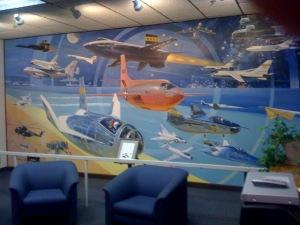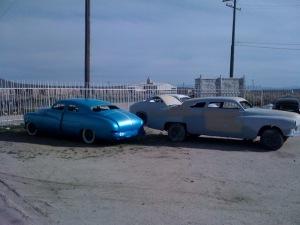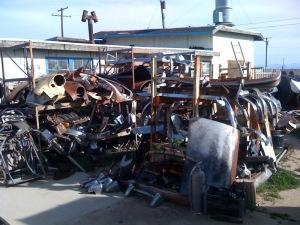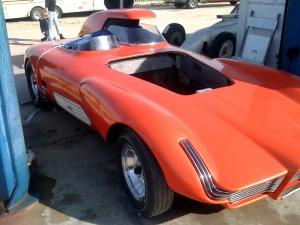Desert Planes and Automobiles
I’ve just spent a fascinating day in the desert an hour and a half north of Los Angeles.
It was an Art Center College of Design field trip. First stop was a hangar-cum-workshop at the Mojave airport — officially, and very grandly, the Mojave Air and Space Port — where I met Jon Sharp, a charming, civilized 50-something guy who built (with his wife Patricia) and races a two-seat airplane called NemesisNXT.
The plane is made from a so-called ‘composite’ material — molded plastic pieces glued together, essentially, like a giant model airplane. Last fall at a race in Reno he flew 409 miles per hour, which is now the world record for his class of homebuilt plane. When NemesisNXT turns at those speeds it subjects Jon to 6 Gs of gravitational force. He also said he’s flown the little plane from my home state of Nebraska back to Mojave in four hours, including a stop for gas, which is amazing.
You can buy a kit from the Sharps to build your own NemesisNXT, which will run you something over $300,000.
On the other side of the airport — Space Port, I mean — is Scaled Composites, which is the 320-employee company founded and still presided over by Burt Rutan, the most famous living aircraft designer. Among other achievements, Rutan designed the Voyager, the first plane to circumnavigate the planet nonstop without refueling, and SpaceShipOne, the first private spacecraft.
At Scaled I met Bob Williams, the company’s program manager, who hates the federal government (a frequent client) and “the media,” and doesn’t seem to think that climate change is a result of human activity. But he obviously loves helping to build unprecedented, record-setting aeronautical marvels, and he was hard not to like.
Twenty minutes from there — that is, in this wide-open part of the world, next door — I toured NASA’s Dryden Research Center, which is on Edwards Air Force Base. CIVILIANS WELCOME! says the sign in the cafeteria, and the portraits of Barack Obama and Joe Biden are already up.

A mural inside the NASA research center at Edwards AFB

One of NASA’s F-18s (I think) in its hangar
There we saw historic planes (such as an X-15, which was the subject of the first non-fiction book I read as a child) and the research planes they use today — such as an autonomous robot plane that can fly on its own for 31 hours.

On the way back to L.A., my Art Center pal Nik Hafermaas took me to the middle-of-nowhere headquarters of Gene Winfield. In certain circles, Winfield is a god: now 81, he is an old-school hot-rodder and custom-car designer who has made cars for movies (including Back tothe Future, RoboCop and Blade Runner) and still makes them for well-to-do car freaks.

His parts yard, where we wandered and stared as a bluesy rock instrumental blasted from behind a closed shodoor, was like an art installation.



A concept car Winfield designed for Detroit a half century ago
At the end of my day in America — a version of the country that I’d never really stepped into, and had really only read about, in The Right Stuff and The Kandy-Kolored Tangerine-Flake Streamline Baby — I was utterly bedoozled. The desert sun helped.
